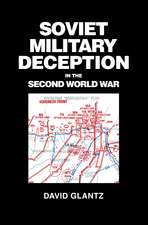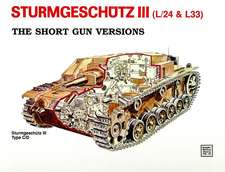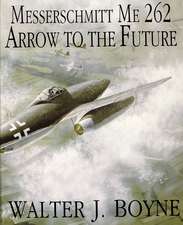Endgame at Stalingrad: November 1942 the Stalingrad Trilogy, Volume 3: Modern War Studies (Hardcover)
Autor David M. Glantz Jonathan M. Houseen Limba Engleză Hardback – 13 mar 2014
When "Volume Two" left off, Germany s vaunted Sixth Army, already deflected from its original goal the Caucasus oil fields had been drawn into a desperate war of attrition within the ravaged city of Stalingrad. In "Volume Three, Book One," we see the ultimate consequences of the Germans overreach and the gathering force of the Red Army s massive manpower and increasingly sophisticated command. After failing repeatedly to find and exploit the weaknesses in Axis defenses, Stalin and the "Stavka" (High Command) finally seized their chance in mid-November of 1942 by launching a bold and devastating counteroffensive, Operation Uranus.
Glantz draws a detailed and vivid account of how, in Operation Uranus, the Red Army s three "fronts" defeated and largely destroyed two Romanian armies and encircled the German Sixth Army and half of the German Fourth Panzer Army in the Stalingrad pocket turning the Germans world on its head. Like its predecessor volumes, this one makes extensive use of sources previously out of reach or presumed lost, such as reports from the Sixth Army s combat journal and newly released Soviet and Russian records. These materials (many cited at length or printed in their entirety in a companion volume) lend themselves to a strikingly new interpretation of the campaign s planning and execution on both sides a version of events that once and for all gets at the ground truth of this historic confrontation."
Din seria Modern War Studies (Hardcover)
-
 Preț: 492.16 lei
Preț: 492.16 lei -
 Preț: 437.96 lei
Preț: 437.96 lei -
 Preț: 444.71 lei
Preț: 444.71 lei -
 Preț: 498.91 lei
Preț: 498.91 lei -
 Preț: 407.59 lei
Preț: 407.59 lei -
 Preț: 397.19 lei
Preț: 397.19 lei -
 Preț: 443.13 lei
Preț: 443.13 lei -
 Preț: 432.18 lei
Preț: 432.18 lei -
 Preț: 436.98 lei
Preț: 436.98 lei -
 Preț: 489.28 lei
Preț: 489.28 lei -
 Preț: 444.86 lei
Preț: 444.86 lei -
 Preț: 396.27 lei
Preț: 396.27 lei -
 Preț: 437.96 lei
Preț: 437.96 lei -
 Preț: 401.69 lei
Preț: 401.69 lei -
 Preț: 408.36 lei
Preț: 408.36 lei -
 Preț: 347.30 lei
Preț: 347.30 lei - 15%
 Preț: 435.41 lei
Preț: 435.41 lei -
 Preț: 395.28 lei
Preț: 395.28 lei -
 Preț: 399.32 lei
Preț: 399.32 lei -
 Preț: 494.11 lei
Preț: 494.11 lei -
 Preț: 393.37 lei
Preț: 393.37 lei -
 Preț: 439.87 lei
Preț: 439.87 lei -
 Preț: 444.71 lei
Preț: 444.71 lei -
 Preț: 500.82 lei
Preț: 500.82 lei -
 Preț: 445.63 lei
Preț: 445.63 lei -
 Preț: 497.18 lei
Preț: 497.18 lei -
 Preț: 447.58 lei
Preț: 447.58 lei -
 Preț: 397.04 lei
Preț: 397.04 lei -
 Preț: 511.52 lei
Preț: 511.52 lei -
 Preț: 440.84 lei
Preț: 440.84 lei -
 Preț: 403.78 lei
Preț: 403.78 lei -
 Preț: 397.04 lei
Preț: 397.04 lei -
 Preț: 392.41 lei
Preț: 392.41 lei -
 Preț: 438.93 lei
Preț: 438.93 lei -
 Preț: 438.72 lei
Preț: 438.72 lei -
 Preț: 440.25 lei
Preț: 440.25 lei -
 Preț: 440.67 lei
Preț: 440.67 lei -
 Preț: 442.37 lei
Preț: 442.37 lei -
 Preț: 491.61 lei
Preț: 491.61 lei -
 Preț: 319.50 lei
Preț: 319.50 lei -
 Preț: 497.00 lei
Preț: 497.00 lei -
 Preț: 414.56 lei
Preț: 414.56 lei -
 Preț: 443.72 lei
Preț: 443.72 lei -
 Preț: 443.72 lei
Preț: 443.72 lei -
 Preț: 492.16 lei
Preț: 492.16 lei -
 Preț: 446.62 lei
Preț: 446.62 lei -
 Preț: 439.87 lei
Preț: 439.87 lei -
 Preț: 503.54 lei
Preț: 503.54 lei - 15%
 Preț: 435.87 lei
Preț: 435.87 lei
Preț: 496.23 lei
Nou
Puncte Express: 744
Preț estimativ în valută:
94.95€ • 99.14$ • 78.59£
94.95€ • 99.14$ • 78.59£
Carte disponibilă
Livrare economică 14-28 martie
Preluare comenzi: 021 569.72.76
Specificații
ISBN-13: 9780700619542
ISBN-10: 0700619542
Pagini: 680
Dimensiuni: 165 x 236 x 53 mm
Greutate: 1.14 kg
Ediția:New.
Editura: University Press of Kansas
Seria Modern War Studies (Hardcover)
ISBN-10: 0700619542
Pagini: 680
Dimensiuni: 165 x 236 x 53 mm
Greutate: 1.14 kg
Ediția:New.
Editura: University Press of Kansas
Seria Modern War Studies (Hardcover)
Descriere
The campaign intended to secure the Wehrmacht's flanks had proven one front too many for the German Army. And now the offensive at Stalingrad, the epic clash that marked Germany's failure on the Eastern Front, was entering its grim final phase. In Book One of the third volume of his acclaimed "Stalingrad Trilogy," David Glantz offers the definitive account--the "ground truth" to counter a half-century's worth of myth and misinformation--of the beginning of the end of one of the most infamous battles of the Second World War, and one of the most costly in lives and treasure in the annals of history.
When "Volume Two" left off, Germany's vaunted Sixth Army, already deflected from its original goal--the Caucasus oil fields--had been drawn into a desperate war of attrition within the ravaged city of Stalingrad. In "Volume Three, Book One," we see the ultimate consequences of the Germans' overreach and the gathering force of the Red Army's massive manpower and increasingly sophisticated command. After failing repeatedly to find and exploit the weaknesses in Axis defenses, Stalin and the "Stavka" (High Command) finally seized their chance in mid-November of 1942 by launching a bold and devastating counteroffensive, Operation Uranus.
Glantz draws a detailed and vivid account of how, in Operation Uranus, the Red Army's three "fronts" defeated and largely destroyed two Romanian armies and encircled the German Sixth Army and half of the German Fourth Panzer Army in the Stalingrad pocket--turning the Germans' world on its head. Like its predecessor volumes, this one makes extensive use of sources previously out of reach or presumed lost, such as reports from the Sixth Army's combat journal and newly released Soviet and Russian records. These materials (many cited at length or printed in their entirety in a companion volume) lend themselves to a strikingly new interpretation of the campaign's planning and execution on both sides--a version of events that once and for all gets at the ground truth of this historic confrontation.
When "Volume Two" left off, Germany's vaunted Sixth Army, already deflected from its original goal--the Caucasus oil fields--had been drawn into a desperate war of attrition within the ravaged city of Stalingrad. In "Volume Three, Book One," we see the ultimate consequences of the Germans' overreach and the gathering force of the Red Army's massive manpower and increasingly sophisticated command. After failing repeatedly to find and exploit the weaknesses in Axis defenses, Stalin and the "Stavka" (High Command) finally seized their chance in mid-November of 1942 by launching a bold and devastating counteroffensive, Operation Uranus.
Glantz draws a detailed and vivid account of how, in Operation Uranus, the Red Army's three "fronts" defeated and largely destroyed two Romanian armies and encircled the German Sixth Army and half of the German Fourth Panzer Army in the Stalingrad pocket--turning the Germans' world on its head. Like its predecessor volumes, this one makes extensive use of sources previously out of reach or presumed lost, such as reports from the Sixth Army's combat journal and newly released Soviet and Russian records. These materials (many cited at length or printed in their entirety in a companion volume) lend themselves to a strikingly new interpretation of the campaign's planning and execution on both sides--a version of events that once and for all gets at the ground truth of this historic confrontation.


















